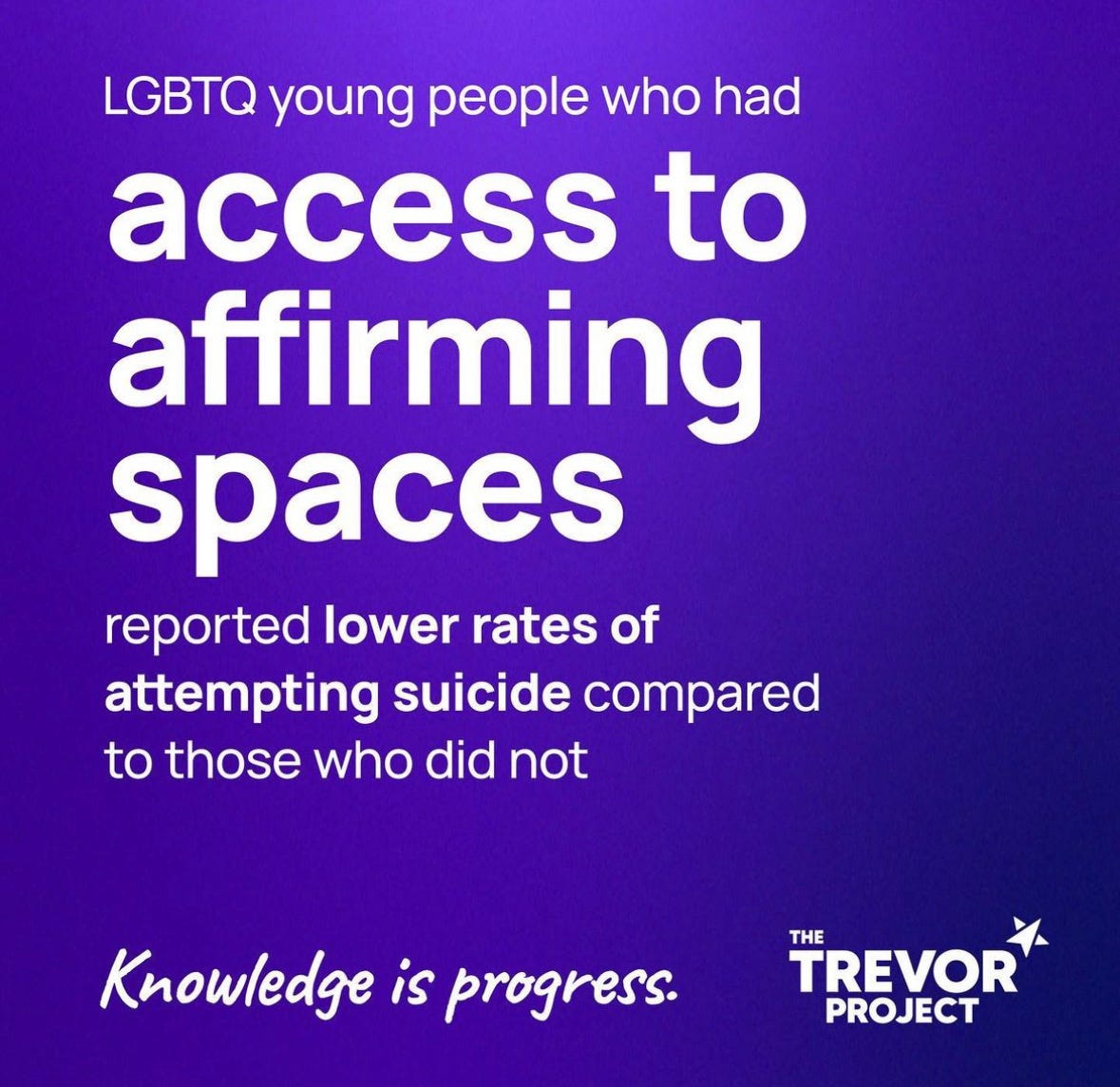“There are only two genders.”
“Men can’t be women.”
“Men and women are different.”
“There’s no such thing as a trans child.”
These statements seem obvious to some and many others, yet they still clash with friends and family who believe transgenderism is real. They think, “It’s common sense—what’s going on here?”
I’ll tell you - They are speaking a different language. They assume a certain set of beliefs. They don’t understand the gender religion.
Most people who believe in transgenderism recognize men and women exist, but they believe their sexed bodies are inconsequential. They believe their bodies are vessels and their inner gender being is transcendent. This is an element of queer theory.
Via google AI: Queer theory is a field of critical theory that examines and critiques society's definitions of gender and sexuality, challenging traditional assumptions about what is "normal" and exploring the social and power structures that shape our understanding of identity.
They certainly wouldn’t agree that “there’s no such thing as a trans child.” They believe these children possess a special soul requiring affirmation. Without physical and emotional affirmation, they argue, these kids will die—it’s life or death to them. This may sound like hyperbole, but many genuinely believe denying this truth leads to death. Studies “proving” this have been quietly debunked, yet they persist in prominent institutions. For example, the Society for Evidence-Based Gender Medicine (SEGM) cites a retracted study on sex changes, while Sex Matters explains why these studies are flawed and how this misinformation has spread across major organizations.
The Trevor Project
The Trevor Project claims LGBTQ young people with access to “affirming spaces” report lower rates of attempting suicide. Notice this data is self-reported (likely via leading surveys) and doesn’t account for completed suicides—only self-reported attempts. This population is repeatedly told they must be affirmed or harm themselves, so naturally, they report more suicidal thoughts and gestures. This data is meaningless.
Their view of children differs sharply. They believe children know themselves, and adults must listen—children must lead. Some claim this applies even at birth. Psychologist Diane Ehrensaft, PhD, claims babies send “gender messages” by wearing a onesie like a dress or removing barrettes. She elaborates in a 2015 essay on the UCSF website and, in a 2014 video, discusses “gender hybrids” and “gender smoothies” with a straight face:
They argue intersex conditions and clownfish prove multiple genders exist. They overlook that humans still only produce male or female gametes, regardless of rare birth defects. They also cite anomalies like clownfish and seahorses to bolster their case. Yet, despite which fish lays the eggs, these species remain male or female. Plus, trans activists forget a basic fact: humans aren’t fish.
An Orthodoxy of Queer?
Even transexuals—people who surgically alter their bodies to align with the opposite sex—aren’t 'evolved' enough for queer theory adherents. Transexuals and transgenders differ—most transexuals acknowledge a mental health struggle, accept two sexes, and seek to blend in quietly, not challenge norms loudly. The modern trans movement has sidelined them.
Queer theory aims to upend everything “normal.” The notion of male and female is humanity’s most basic truth, yet activists have convinced millions that multiple genders exist—a profound shift.
So, if you’re a logical person and someone you love believes illogical things, what do you do?
Patience is a Virtue
First, you must practice a lot of patience. The reason for that is you will need to remember that your logical, common-sense worldview does not align with a trans believer. If you really want to get through to someone and not butt heads, I recommend that you stop using the phrases above. They only reinforce the wedge this ideology intentionally places between you and the person you are trying to reach.
You must understand that your loved one has joined a new religion, and religions don’t respond well to logical statements. They need facts and truth, but you still must appeal to feelings and strategically poke holes in their faulty belief system. What feelings am I talking about? Consider what feelings might draw the person you care about to reject logic. Some possibilities are feelings of isolation, fear, sadness, and vulnerability. Pay attention to who are talking to. Listen and learn, even though a lot won’t make any sense. Sasha Ayad, LPC just tweeted “Take the distress SERIOUSLY, but not LITERALLY.” While you attempt to be gentle, if you are the parent, you must also remember your authority. You must set limits with internet access and the friend groups that are influencing your child. Your conversations can evolve as more logic penetrates.
There are so many things you can do, especially as a parent of a minor, but this essay aims to help people understand broadly why you can so quickly hit a wall when it comes to having an honest conversation with a person who believes transgenderism is a real inner phenomenon. You must learn their language first before you can communicate yours.
You can learn more about the trans language, including a “Trans/English” dictionary in my book, A Practical Response to Gender Distress: Tips and Tools for Families, available on Amazon. In order to mend this horrible divide in our country, we must first learn how to communicate with people who think very differently, especially those we love.
Pamela Garfield-Jaeger is a licensed clinical social worker from California. She earned her MSW from New York University in 1999 and has worked in schools, group homes, hospitals, and community-based organizations. She now educates parents and emboldens mental health professionals to challenge the ideological capture of her field.
For more on empowering yourself as a parent and navigating mental health, see the Parents’ Guide to Mental Health. Pamela authored A Practical Response to Gender Distress, available on Amazon.
Coming Spring 2025: Froggy Girl, a charming children’s book about self-acceptance.
Genspect publishes a variety of authors with different perspectives. Any opinions expressed in this article are the author’s and do not necessarily reflect Genspect’s official position. For more on Genspect, visit our FAQs.








“Most people who believe in transgenderism recognize men and women exist, but they believe their sexed bodies are inconsequential.”
I’ve been following a few popular trans activists. I think they would take exception to this claim in a telling way. I think they would roll their eyes, exasperatingly sigh and say “no one is saying sexed bodies are inconsequential” and then add something like “that’s the reason why people who know they are in the wrong body must change it and why they are literally, even biologically, the gender they know they are.”
The claim gets more complicated the more you push. They would say it’s not a gendered soul but suggest it’s a type of unobservable intersex situation. They’d say they are biological and they are a woman so they are a biological woman. And science supports their view and not the Gender Critical View which believes “in an unchangeable gendered soul that stays with the body even after surgery”. Arguing that sex is a cluster of observable traits that you can change to conform with your identity.
I think the problem is social constructivism. Or autistic thinking. Or nominalism. It makes people’s minds spin and I think they give up in confusion when faced with someone who sounds smart making no sense by changing the meaning of words in front of your eyes.
An interesting article. I thought the clownfish example had fallen by the wayside but it reared its head in a conversation I was having with a true believer on Facebook a couple of weeks or so ago. There are people out there who believe we are fish. I really don't know what to think.